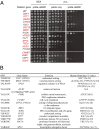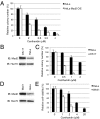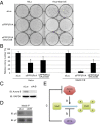Synthetic genetic array screen identifies PP2A as a therapeutic target in Mad2-overexpressing tumors
- PMID: 24425774
- PMCID: PMC3910639
- DOI: 10.1073/pnas.1315588111
Synthetic genetic array screen identifies PP2A as a therapeutic target in Mad2-overexpressing tumors
Abstract
The spindle checkpoint is essential to ensure proper chromosome segregation and thereby maintain genomic stability. Mitotic arrest deficiency 2 (Mad2), a critical component of the spindle checkpoint, is overexpressed in many cancer cells. Thus, we hypothesized that Mad2 overexpression could specifically make cancer cells susceptible to death by inducing a synthetic dosage lethality defect. Because the spindle checkpoint pathway is highly conserved between yeast and humans, we performed a synthetic genetic array analysis in yeast, which revealed that Mad2 overexpression induced lethality in 13 gene deletions. Among the human homologs of candidate genes, knockdown of PPP2R1A, a gene encoding a constant regulatory subunit of protein phosphatase 2, significantly inhibited the growth of Mad2-overexpressing tumor cells. PPP2R1A inhibition induced Mad2 phosphorylation and suppressed Mad2 protein levels. Depletion of PPP2R1A inhibited colony formation of Mad2-overexpressing HeLa cells but not of unphosphorylated Mad2 mutant-overexpressing cells, suggesting that the lethality induced by PP2A depletion in Mad2-overexpressing cells is dependent on Mad2 phosphorylation. Also, the PP2A inhibitor cantharidin induced Mad2 phosphorylation and inhibited the growth of Mad2-overexpressing cancer cells. Aurora B knockdown inhibited Mad2 phosphorylation in mitosis, resulting in the blocking of PPP2R1A inhibition-induced cell death. Taken together, our results strongly suggest that PP2A is a good therapeutic target in Mad2-overexpressing tumors.
Keywords: aneuploidy; anticancer drug; cancer therapy target; yeast genetics.
Conflict of interest statement
The authors declare no conflict of interest.
Figures







References
-
- Li R, Murray AW. Feedback control of mitosis in budding yeast. Cell. 1991;66(3):519–531. - PubMed
-
- Li Y, Benezra R. Identification of a human mitotic checkpoint gene: hsMAD2. Science. 1996;274(5285):246–248. - PubMed
-
- Cahill DP, et al. Mutations of mitotic checkpoint genes in human cancers. Nature. 1998;392(6673):300–303. - PubMed
Publication types
MeSH terms
Substances
Grants and funding
LinkOut - more resources
Full Text Sources
Other Literature Sources
Miscellaneous

